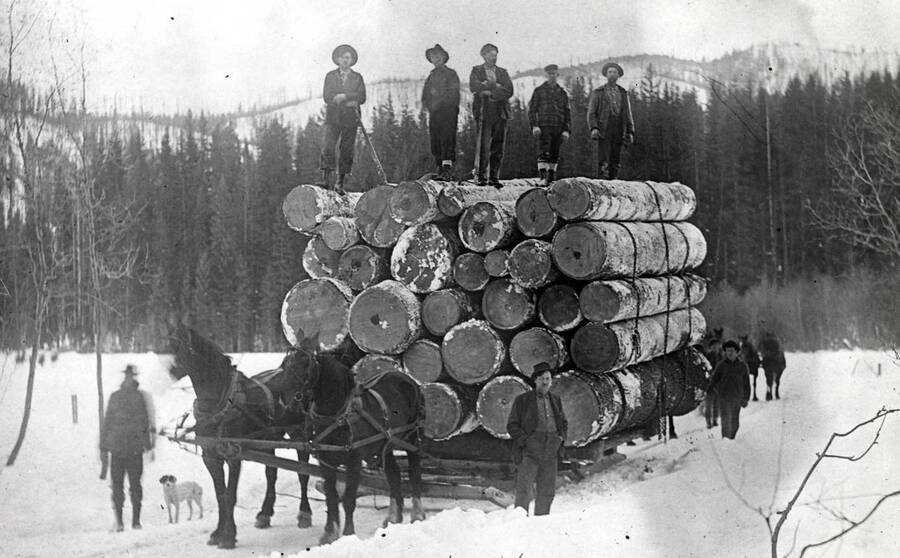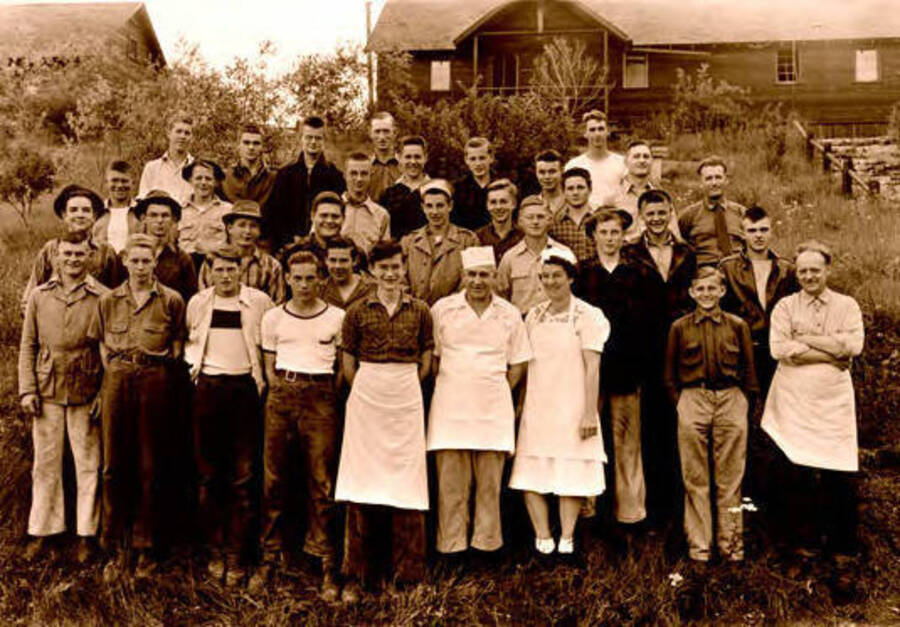Priest Lake Historical Photograph Collection
Historical Photographs of Priest lake, Idaho and the surrounding area, 1880 - 1950
Contents: Brief History of Priest Lake, Idaho | About the Photographs | Sources | Tech
Brief History of Priest Lake, Idaho
Priest Lake is located in the Idaho Panhandle and is part of the Idaho Panhandle National Forests. The lake was originally called “Kaniksu Lake” by Captain John Mullan in 1865. According to some accounts, “the name was gradually changed in the early 1900’s from Kaniksu Lake to its present name of Priest Lake,” with the name “Priest” coming from “the Kalispel Indian word Kaniksu, meaning ‘Black Robe,’ the name the Indians gave to the Jesuit missionary priests who worked among them.”1 As a result, Priest Lake appears as Kaniksu Lake on many older maps.
The history of Priest Lake begins with the history of Priest River, some 40 miles south of the lake. The first non-indigenous settlers in what would eventually become the city of Priest River were German immigrants who settled around 1888-1889.2 As recounted by local historian Marylyn Cork, the early 1890s brought a flood of southern Italian immigrants who came to the Priest River area “to hew ties for the Great Northern Railroad” and ever since then, “the woods product industry has fueled Priest River’s economic engine.”2 Many Italian immigrants who arrived in the early 1890s to work on railroads ended up staying even after the railroads were finished. Many of them “settled an area on the east side of the town and the river that became known as the Italian Settlement. The Italian influx continued until about 1920. Priest River was known as ‘Little Italy’ until well into the 1950s.”2
Although early settlers in the Priest River area looked for economic opportunities in agriculture and mining, they found little success. Logging would become the area’s legacy: “For decades, Priest River was a wide-open logging town. By 1920, according to the census, it was the fastest growing town in North Idaho.”2
The logging industry that began around Priest River slowly expanded to include the Priest Lake area. “From 1901 through 1949, an annual log drive on the Priest River took place each spring as the industry worked its way into the Priest Lake country.”2 Priest Lake became known as a logging town.
About the Photographs
This collection depicts seventy years of family, community, and business life in the Priest Lake area. Earlier photos show homesteads as well as Prater Ranch, also known as “half-way house,” where, during the regular trips from Priest River to Priest Lake, the stage stopped to exchange horses and provide a place for its passengers to have a mid-day meal. Many images also depict logging activity. There are images of logs on sleds drawn by horses, log booms pulled by steamboats moving between Priest River and Priest Lake, and logs on multi-trailer trucks traversing snow-covered roads.
Some photos include Nell Shipman, a Canadian-American “silent screen actress, writer, and producer” who is known as “one of cinema’s important female pioneers.”3 She “ran a motion picture company from the isolated woods of Idaho” between 1921-1925 after moving “her production company from Southern California, first to Spokane, Washington, and finally to Lionhead Lodge on the shore of Priest Lake, Idaho.”4 She finished shooting The Grub Stake (1922) at Priest Lake, the first silent picture the company shot in the Pacific Northwest. However, “before leaving for Idaho, Shipman had begun purchasing a zoo located in Azusa, California” and brought her zoo to Idaho with her to star with her in the silent movies.4 For more information about Nell Shipman, please refer to the Nell Shipman Papers at Boise State University Library, Special Collections and Archives.
Some photos in this collection are related to the history of Blister Rust Disease in the Priest Lake and Priest River area. Blister Rust is a non-native fungus that is extremely damaging to white pine trees.5 In North Idaho, “white pine populations were dramatically reduced in the early 1900s due to blister rust.”6 As such, the federal government sought to combat the disease and attempt to slow the spread amongst white pines in the 1930s. The photos in this collection depict life as a blister rust control worker, and more information about this history can be found here.7 The federal government relied on labor from the newly founded Civilian Conservation Corp (CCC), whose memberes not only worked on disease control and fought fires, but also built fire lookouts, campgrounds, and roads. The federal government later used these camps to house German and Italian internees during World War II, also pictured in this collection.
“The Priest Lake Museum Association built the collection in the early 1980s after putting out a call for historical photos of the region.”8 With the help of grant funding provided by the Greater Inland Empire Foundation and the Association for the Humanities in Idaho, members of the association went about gathering photographs from those who answered their call. These photographs were eventually hand-delivered to the University of Idaho Library’s Special Collections & Archives Department, where they were digitized, reprinted, and then returned, via the Museum Association, to their original owners.
Archival Context
For a detailed description and inventory of the Priest Lake Historical Photograph Collection, see our finding aid. Physical collections are held by Special Collections and Archives.
Sources
- Marylyn Cork, Jeanne M. Tomlin, and Diane E. Mercer, Priest River and Priest Lake: Kaniksu Country (Images of America, Arcadia Publishing, 2012).
- Kris Runberg Smith, ed. Pioneer Voices of Priest Lake (Keokee Books, 2007). Available in SPEC, Day-NW F.782 P75 2007.
-
“Priest Lake Ranger District - Idaho Panhandle N.F.,” United States Department of Agriculture: Forest Service, accessed May 7, 2020. ↩
-
Marylyn Cork, “History,” Priest River Chamber of Commerce, accessed May 7, 2020. ↩ ↩2 ↩3 ↩4 ↩5
-
“Nell Shipman Point,” North Idaho: The Northwest’s Playground, acessed May 7, 2020, https://visitnorthidaho.com/activity/nell-shipman-point/. (Archived: https://perma.cc/J3ZP-QNVA) ↩
-
Tom Trusky, “Nell Shipman,” Women Film Pioneers Project, accessed May 8, 2020, https://wfpp.columbia.edu/pioneer/ccp-nell-shipman/. (Archived: https://perma.cc/V3L6-BWT7) ↩ ↩2
-
“Western White Pine,” United States Department of Agriculture: Forest Service, accessed May 8, 2020. and Matthew Weaver, “UI Extension Workshop Looks to Restore Western White Pine,” Capital Press: Empowering Producers of Food & Fiber, accessed May 14, 2019, https://www.capitalpress.com/ag_sectors/timber/ui-extension-workshop-looks-to-restore-western-white-pine/article_913680b8-7350-11e9-a40f-b3ec1d248290.html (Archived: https://perma.cc/U6BD-2BE7) ↩
-
Matthew Weaver, “UI Extension Workshop Looks to Restore Western White Pine,” Capital Press: Empowering Producers of Food & Fiber, accessed May 14, 2019, https://www.capitalpress.com/ag_sectors/timber/ui-extension-workshop-looks-to-restore-western-white-pine/article_913680b8-7350-11e9-a40f-b3ec1d248290.html (Archived: https://perma.cc/U6BD-2BE7) ↩
-
Carl Gidlund, “Life as Blister Rust Control Worker,” The Spokesman-Review, accessed May 8, 2020, https://www.spokesman.com/stories/2005/oct/29/life-as-blister-rust-control-worker/. (Archived: https://perma.cc/BGT5-5RSD) ↩
-
Scott Maben, “Priest Lake History Told through Just-Released Photo Collection,” The Spokesman-Review, March 14, 2013., https://www.spokesman.com/stories/2013/mar/14/lake-views/. (Archived: https://perma.cc/FH7H-MGPM) Also, see the call on page 2 of The Priest Lake Museum Association Newsletter, Spring 1984. ↩
Technical Credits - CollectionBuilder
This digital collection is built with CollectionBuilder, an open source framework for creating digital collection and exhibit websites that is developed by faculty librarians at the University of Idaho Library following the Lib-Static methodology.
Using the CollectionBuilder-CSV template and the static website generator Jekyll, this project creates an engaging interface to explore driven by metadata.


